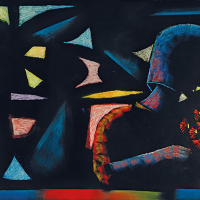34. CHARLES BLACKMAN

It is not surprising that many commentaries on the work of Charles Blackman begin by noting his rapid rise to prominence through his Alice in Wonderland series and it is interesting to speculate just why that happened. Timing is everything in art, as in most human pursuits, and Blackman was fortunate in being born to a generation just too young to see service in the Second World War. While his childhood was far from easy, with the family being abandoned by the husband and father at the height of the Great Depression, he did have a precocious talent as a child and a supportive mother who pushed that ability. He left school at just 13 and managed to secure a position as a cadet illustrator on the Sydney Sun. With the war coming close to Australian shores in 1941, conscription was introduced, with all fit young men being eligible for military service. Those not emotionally or physically cut out for active service were still in uniform, with artists such as Albert Tucker (1914-1999), Arthur Boyd (1920-1999), Sidney Nolan (1917-1992) and John Perceval (1923-2000) posted to various military establishments around the country. This left an opportunity for youngsters such a Blackman to fill positions for which they might not otherwise be eligible. The discipline of regular work and the firm guidance of a good art director were powerful motivating factors, and the young artist supplemented his work with night classes at East Sydney Technical College. While his disposition did not sit well with the formal teaching being offered, the contact with other young artists was valuable, even though he failed to finish the course. The war ended while Blackman was still too young to serve, so he was able to move into the new peacetime world with the confidence brought on by four solid years of paid work and exposure to a range of artistic possibilities.
In 1950 Blackman married Barbara Patterson and a year later the pair would head for Melbourne and, again, his timing was good. The modern movement in Melbourne had advanced strongly through the war years with the formation and success of the Contemporary Art Society, laying fertile ground for an adventurous young artist with a fresh take on creative expression. The group who had dominated in the war years had all decamped to the UK and Europe, with the organisers, such as John and Sunday Reed (1901-1981; 1905-1981) and the Georges and Mirka Mora (1913-1992; 1928-2018), ready to embrace new talent to fill the void. There was a clear place for new artists who could deliver a form of modernism that was interesting and attractive but without the heavy shadow of artists such as Albert Tucker, whose personal mantra that art should be as difficult for the viewer as it is for the artist a bridge too far for a new generation of collectors energised by a bright new future in a peaceful world. Blackmans schoolgirls and the Alice paintings seemed to fit the bill perfectly. They were modern, quirky and intensely personal, but not imbued with the dark terrors of war and psychological angst.
As a mature mid-career artist Blackman continued to explore subjects with psychological and personal insight, especially as Barbaras sight began to fail and he imagined worlds were light and colour gave way to darkness, in works that still carried a warm, decorative element that balanced the black night. His Girl with Flowers pictures a young girl, turned away from the viewer in dark silhouette, as she holds a spare bunch of withered flowers. She is shadowed away from the light and colour of what might be seen as a fragment of Leonard Frenchs (1928-2017) exciting new glass ceiling in the Great Hall of the National Gallery of Victoria, opened not long before Blackmans work was painted. The secret to that work is the careful balance between the dense black surround and the glowing colour of the brilliant glass slabs, the same design element that sits at the heart of Blackmans painting.
Gavin Fry BA (Hons) MA MPhil